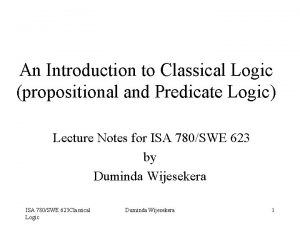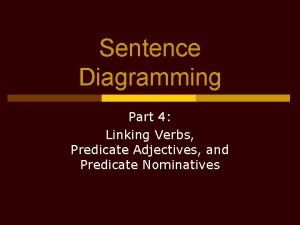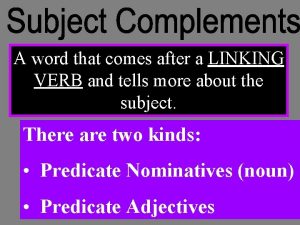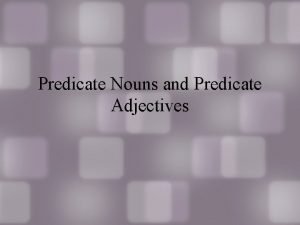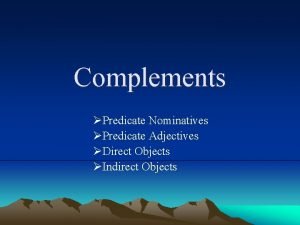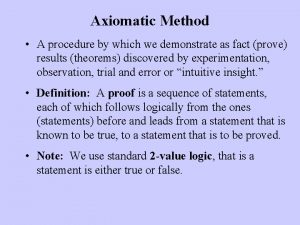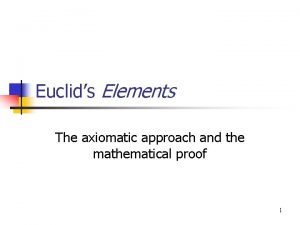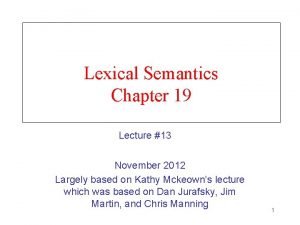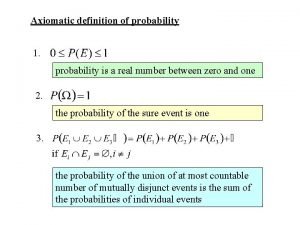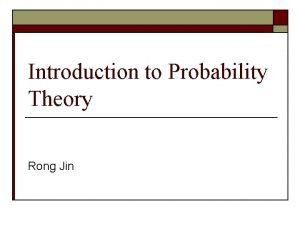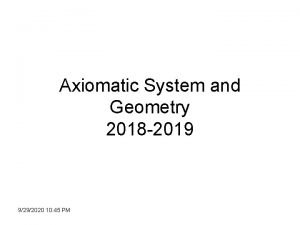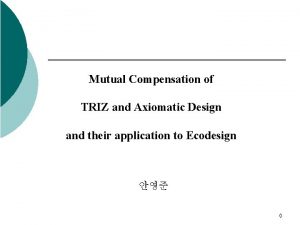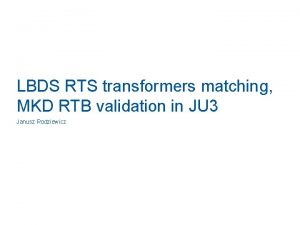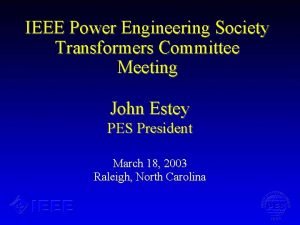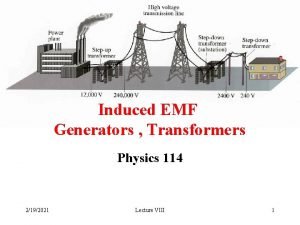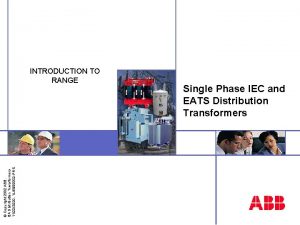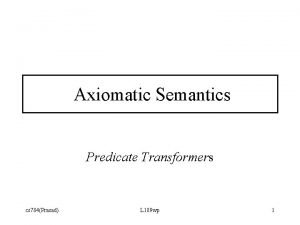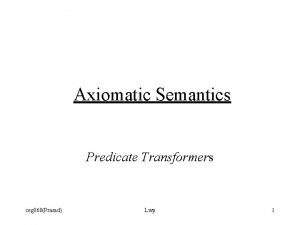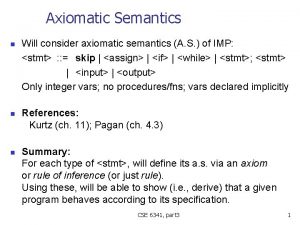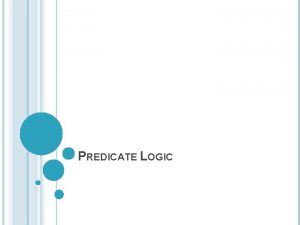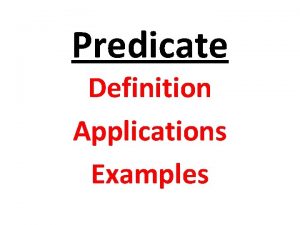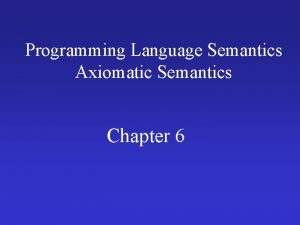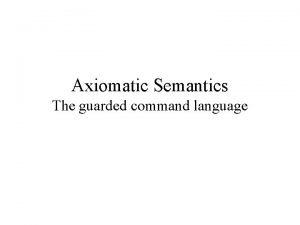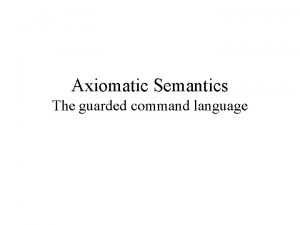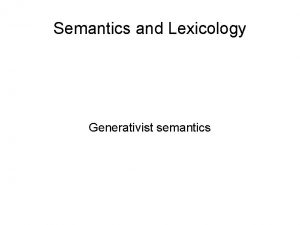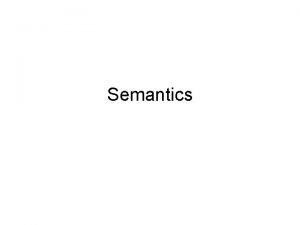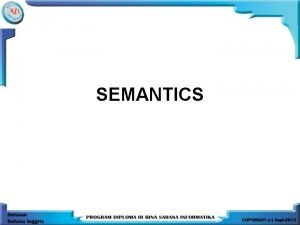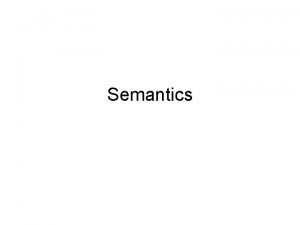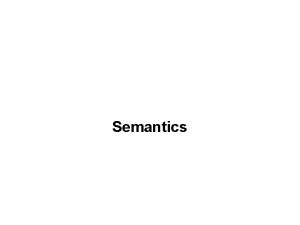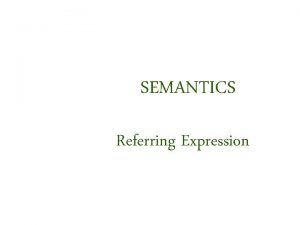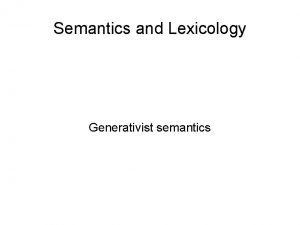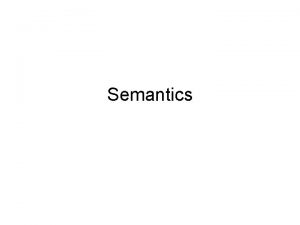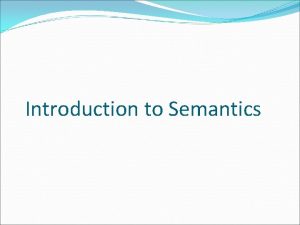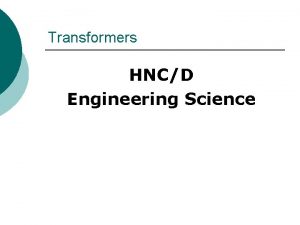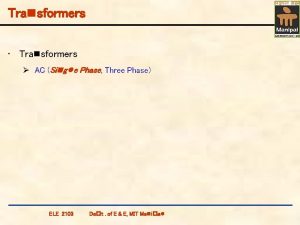Axiomatic Semantics Predicate Transformers cs 7100Prasad L 18









![Axioms and Inference Rules • Assignment axiom {Q[e]} x : = e; {Q[x]} • Axioms and Inference Rules • Assignment axiom {Q[e]} x : = e; {Q[x]} •](https://slidetodoc.com/presentation_image_h/3009d3e9faaafb546fecfcc0548820b9/image-10.jpg)


![Predicate Transformers • Assignment wp( x : = e , Q ) = Q[x<-e] Predicate Transformers • Assignment wp( x : = e , Q ) = Q[x<-e]](https://slidetodoc.com/presentation_image_h/3009d3e9faaafb546fecfcc0548820b9/image-13.jpg)
















- Slides: 29

Axiomatic Semantics Predicate Transformers cs 7100(Prasad) L 18 -9 WP 1

Motivation Input Output • Problem Specification • Properties satisfied by the input and expected of the output (usually described using “assertions”). • E. g. , Sorting problem – Input : Sequence of numbers – Output: Permutation of input that is ordered. • Program • Transform input to output. cs 7100(Prasad) L 18 -9 WP 2

• Sorting algorithms » » Bubble sort; Shell sort; Insertion sort; Selection sort; Merge sort; Quick sort; Heap sort; • Axiomatic Semantics To show that a program satisfies its specification, it is convenient to have a description of the language constructs in terms of assertions characterizing the input and the corresponding output states. cs 7100(Prasad) L 18 -9 WP 3

cs 7100(Prasad) L 18 -9 WP 4

q p cs 7100(Prasad) L 18 -9 WP 5

Axiomatic Approaches • Hoare’s Proof System (partial correctness) • Dijkstra’s Predicate Transformer (total correctness) Assertion: Logic formula involving program variables, arithmetic/boolean operations, etc. Hoare Triples : {P} pre-condition (assertion) cs 7100(Prasad) S {Q} statements (program) L 18 -9 WP post-condition (assertion) 6

Swap Example { x = n and y = m } t : = x; x : = y; y : = t; { x = m and y = n } – program variables vs ghost/logic variables • States : Variables -> Values • Assertions : States -> Boolean (= Powerset of States) cs 7100(Prasad) L 18 -9 WP 7

Partial vs Total Correctness {P} S {Q} • S is partially correct for P and Q if and only if whenever S is executed in a state satisfying P and the execution terminates, then the resulting state satisfies Q. • S is totally correct for P and Q if and only if whenever S is executed in a state satisfying P , then the execution terminates, and the resulting state satisfies Q. cs 7100(Prasad) L 18 -9 WP 8

Examples • Totally correct (hence, partially correct) • { • { x = 11 } x : = 0; { x = 0 } x : = x + 1; { x = 1 } false } x : = 0; { x = 111 } false } while true do; { x = 0 } • { y = 0 } if x <> y then x: = y; { x = 0 } • Not totally correct, but partially correct • { true } while true do; { x = 0} • Not partially correct • { true } if x < 0 then x: = -x; { x > 0 } cs 7100(Prasad) L 18 -9 WP 9
![Axioms and Inference Rules Assignment axiom Qe x e Qx Axioms and Inference Rules • Assignment axiom {Q[e]} x : = e; {Q[x]} •](https://slidetodoc.com/presentation_image_h/3009d3e9faaafb546fecfcc0548820b9/image-10.jpg)
Axioms and Inference Rules • Assignment axiom {Q[e]} x : = e; {Q[x]} • Inference Rule for statement composition {P} S 1 {R} S 2 {Q} {P} S 1; S 2 {Q} • Example {x = y} x : = x+1; {x = y+1} y : = y+1; {x = y} x: =x+1; y: =y+1; {x = y} cs 7100(Prasad) L 18 -9 WP 10

Generating additional valid triples {P} S {Q} from {P’} S {Q’} States P’ P’ cs 7100(Prasad) Q P Q’ L 18 -9 WP 11

Rule of Consequence {P’} S {Q’} and P=>P’ and Q’=>Q {P} S {Q} – – Strengthening the antecedent Weakening the consequent • Example {x=0 and y=0} x: =x+1; y: =y+1; {x = y} {x=y} x: =x+1; y: =y+1; {x<=y or x=5} (+ Facts from elementary mathematics [boolean algebra + arithmetic] ) cs 7100(Prasad) L 18 -9 WP 12
![Predicate Transformers Assignment wp x e Q Qxe Predicate Transformers • Assignment wp( x : = e , Q ) = Q[x<-e]](https://slidetodoc.com/presentation_image_h/3009d3e9faaafb546fecfcc0548820b9/image-13.jpg)
Predicate Transformers • Assignment wp( x : = e , Q ) = Q[x<-e] • Composition wp( S 1 ; S 2 , Q) = wp( S 1 , wp( S 2 , Q )) • Correctness {P} S {Q} = (P => wp( S , Q)) cs 7100(Prasad) L 18 -9 WP 13

Correctness Illustrated P => wp( S , Q) States wp(S, Q) Q P cs 7100(Prasad) L 18 -9 WP 14

Correctness Proof {x=0 and y=0} x: =x+1; y: =y+1; {x = y} • wp(y: =y+1; , {x = y}) = { x = y+1 } • wp(x: =x+1; , {x = y+1}) = { x+1 = y+1 } • wp(x: =x+1; y: =y+1; , {x = y}) = { x+1 = y+1 } = { x = y } • { x = 0 and y = 0 } => { x = y } cs 7100(Prasad) L 18 -9 WP 15

Conditionals { P and B } S 1 {Q} {P and not B } S 2 {Q} {P} if B then S 1 else S 2; {Q} wp(if B then S 1 else S 2; , Q) = (B => wp(S 1, Q)) and (not B => wp(S 2, Q)) = (B and wp(S 1, Q)) or (not B and wp(S 2, Q)) cs 7100(Prasad) L 18 -9 WP 16

“Debugging” Program {true} if x < 0 then x: = -x; { x > 0 } {x < 0} x: = -x; { x > 0 } {x >= 0} ; { x > 0 } (x < 0) => (-x > 0) Because (x < 0) (0 < -x) (x >= 0) => (x > 0) (x = 0) => (x > 0) cs 7100(Prasad) L 18 -9 WP 17

“Invariant”: Summation Program { s = i * (i i : = i + s : = s + = i * (i + 1) / 2 } 1; i; + 1) / 2 } • Intermediate Assertion ( s and i different) { s + i = i * (i + 1) / 2 } • Weakest Precondition { s+i+1 = (i+1) * (i+1+1) / 2 } cs 7100(Prasad) L 18 -9 WP 18

while-loop : Hoare’s Approach {Inv and B} S {Inv} while B do S {Inv and not B} Proof of Correctness {P} while B = P => Inv and {Inv and + cs 7100(Prasad) do S {Q} and {Inv} B} S {Inv} not B => Q} Loop Termination argument L 18 -9 WP 19

{I} while B do S {I and not B} {I and B} 0 iterations: S {I} {I and not B} {I} not B holds 1 iteration: {I} B holds 2 iterations: {I} {I and not B} S not B holds S ; B holds S {I and not B} not B holds • Infinite loop if B never becomes false. cs 7100(Prasad) L 18 -9 WP 20

Example 1 : while-loop correctness { n>0 and x=1 and y=1} while (y < n) [ y++; x : = x*y; ] {x = n!} • Choice of Invariant • {I and not B} => Q • {I and (y >= n)} => (x = n!) • I = {(x = y!) and (n >= y)} • Precondition implies invariant { n>0 and x=1 and y=1} => { 1=1! and n>=1 } cs 7100(Prasad) L 18 -9 WP 21

• Verify Invariant {I and B} => wp(S, I) wp( y++; x: =x*y; , {x=y! and n>=y}) = { x=y! and n>=y+1 } I and B = { x=y! and n>=y } and { y<n } = { x=y! and n>y } • Termination • Variant : ( n - y ) y : 1 -> 2 -> … -> n (n-y) : (n-1) -> (n-2) -> … -> 0 cs 7100(Prasad) L 18 -9 WP 22

Detailed Working wp( y++; x: =x*y; , {x=y! and n>=y}) = wp(y++, {x*y=y! and n>=y}) = wp(y++, {x=y-1! and n>=y}) = {x=y+1 -1! and n>=y+1} = {x=y! and n>y} cs 7100(Prasad) L 18 -9 WP 23

GCD/HCF code PRE: (x = n) and (y = m) • while (x <> y) do ASSERT: (** INVARIANT **) • begin • if x > y then x : = x - y; • else y : = y - x; • end; POST: (x = gcd(n, m)) cs 7100(Prasad) L 18 -9 WP 24

GCD-LCM code PRE: (x = n) and (y = m) • u : = x; v : = y; • while (x <> y) do ASSERT: (** INVARIANT **) • begin • if x > y then x : = x - y; u : = u + v • else y : = y - x; v : = v + u • end; POST: (x = gcd(n, m)) and (lcm (n, m) = (u+v) div 2) cs 7100(Prasad) L 18 -9 WP 25

while-loop : Dijkstra’s Approach wp( while B do S , Q) = P 0 or P 1 or … or Pn or … = there exists k >= 0 such that Pk Pi : Set of states causing i-iterations of while-loop P 0 P 1 Pk+1 cs 7100(Prasad) before halting in a state in = = = Q. not B and Q B and wp(S, P 0) B and wp(S, Pk) L 18 -9 WP 26

States . . . wp Q P 2 P 0 P 1 P 0 => P 0 P 1 cs 7100(Prasad) wp(skip, Q) subset => Q wp(S, P 0) L 18 -9 WP 27

Example 2 : while-loop correctness P 0 Pk P 1 Pk = = { y >= n and x = n! } B and wp(S, Pk-1) { y<n and y+1>=n and x*(y+1) = n! } y=n-k and x=(n-k)! Weakest Precondition Assertion: Wp = there exists k >= 0 such that P 0 or {y = n-k and x = (n-k)!} Verification : P = n>0 and x=1 and y=1 For i = n-1: P => Wp cs 7100(Prasad) L 18 -9 WP 28

Induction Proof Hypothesis : Pk = {y=n-k and x=(n-k)!} Pk+1 = { B and wp(S, Pk) } = y<n and (y+1 = n-k) and (x*(y+1)=(n-k)!) = y<n and (y = n-k-1) and (x = (n-k-1)!) = y<n and (y = n- k+1) and (x = (n- k+1)!) = (y = n - k+1) and (x = (n - k+1)!) Valid preconditions: – { n = 4 and y = 2 and x = 2 } – { n = 5 and x = 5! and y = 6} cs 7100(Prasad) L 18 -9 WP (k = 2) (no iteration) 29
 Compare procedural semantics and declarative semantics.
Compare procedural semantics and declarative semantics. Predicate logic example
Predicate logic example What is predicate nominative
What is predicate nominative The gardener predicate
The gardener predicate Predicate nouns and predicate adjectives
Predicate nouns and predicate adjectives Predicate nominatives and predicate adjectives
Predicate nominatives and predicate adjectives Predicat nominative
Predicat nominative What's a simple predicate
What's a simple predicate How to diagram linking verbs
How to diagram linking verbs Axiomatic design example
Axiomatic design example Additive axiom
Additive axiom The axiomatic method
The axiomatic method Axiomatic design
Axiomatic design Axiomatic antonym
Axiomatic antonym What is a classical probability
What is a classical probability Axiomatic definition of probability
Axiomatic definition of probability Axiomatic system definition
Axiomatic system definition Axiomatic system of geometry
Axiomatic system of geometry Contradiction
Contradiction Resin cast potential transformer
Resin cast potential transformer Rts transformers
Rts transformers Transformers igor
Transformers igor Ieee transformer committee
Ieee transformer committee Functions of transformers
Functions of transformers Generator
Generator Transformers
Transformers Abb distribution transformers
Abb distribution transformers Application of insulator
Application of insulator Sđm
Sđm Josipa mokrovića 12
Josipa mokrovića 12

